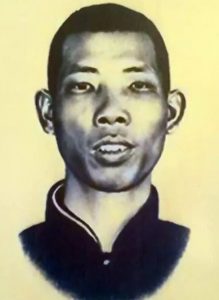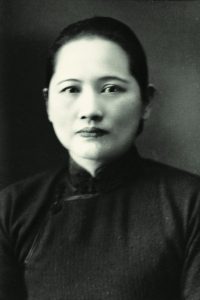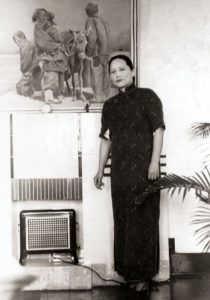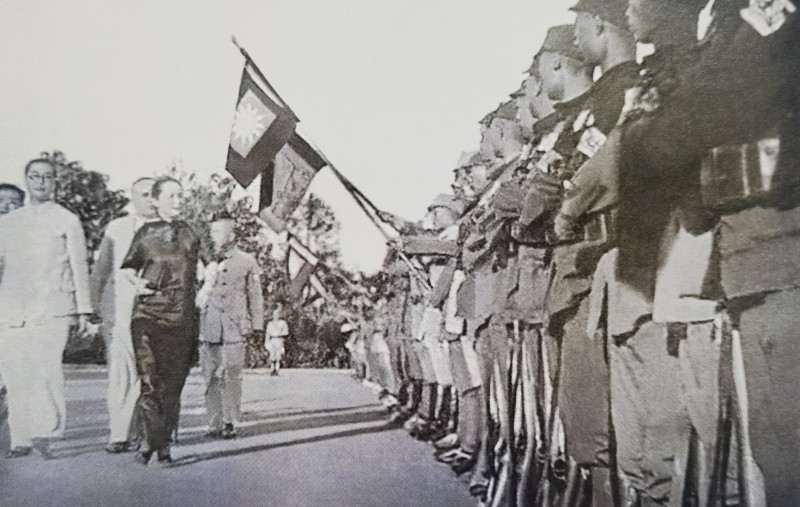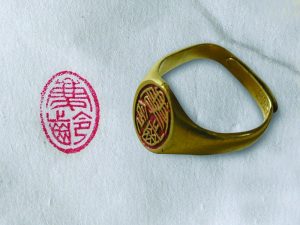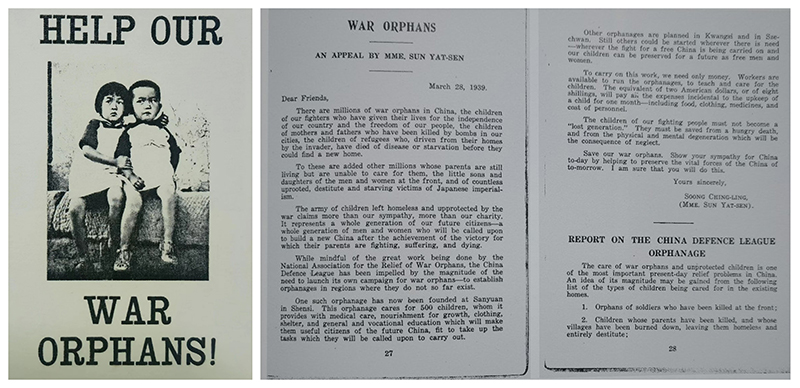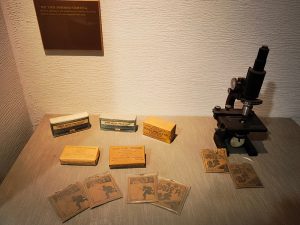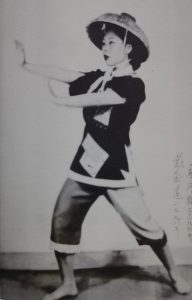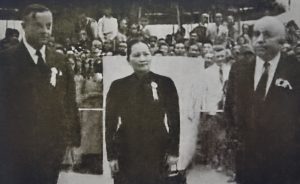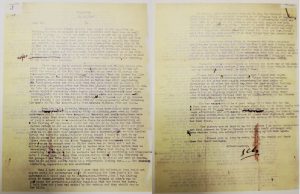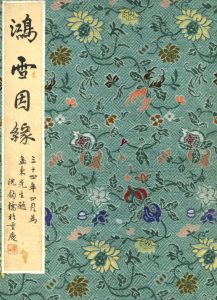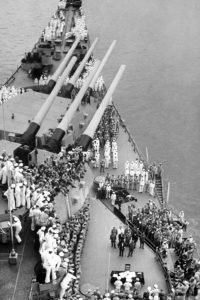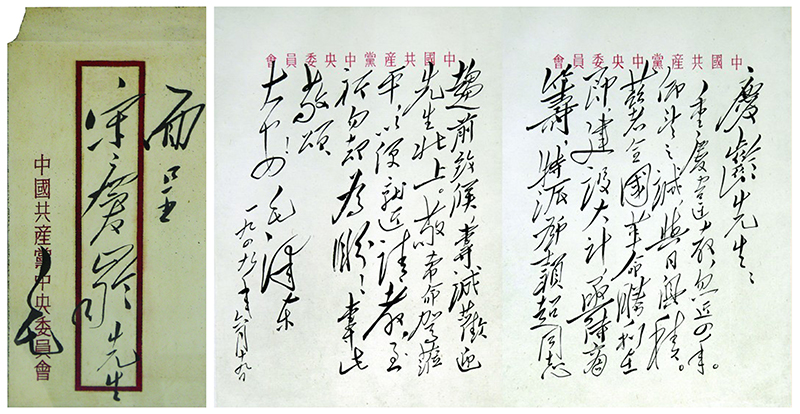Part 3: Madam Soong Ching-ling and the Japanese Occupation of Hong Kong
“Overseas Chinese people in places like Hong Kong have been actively raising fund while labours even cut their living cost to save money for the donation. Dozens of millions were received. They also boycotted Japanese products; organised country saving bodies, extended promotion on international platforms, established serving teams during the wartime, joined and supported the fight with all they have. They should win our applause and we should follow suit. (Madam Soong Ching-ling: “Overseas Chinese Mobilisation” – Second Congress of the Overseas Chinese Mobilisation Council)
| (1) | Madam Soong Ching-ling supported the strike in Guangdong Province and Hong Kong |
A strike broke out in Guangdong Province and Hong Kong in June 1925. An article written by Madam Soong Ching-ling titled “Dr Sun’s Fighting with the British Imperialists for the Custom Surplus for Guangdong and Guangxi” was published in the “Guangzhou National Daily” on 2 July. She said in the article that “follow the view of Dr Sun, act according to his action. If he knew about that, he would be pleased.” She cheered for the fight of the people and the long term struggle of workers in Guangzhou and Hong Kong. This was covered in the article titled “Dr Sun Yat-sen and the May Thirtieth Movement “, which was published in the National Daily.
| (2) | Anna Louise Strong and her book |
Madam Soong Ching-ling received an American reporter, Anna Louise Strong, in Shanghai in end 1925 and facilitated her reporting of the strike in Guangzhou. Madam Soong suggested, “It will be much easier if you take a ship from Shanghai to Guangzhou but not to Hong Kong. However, as a reporter, you should check out the situation in both cities.” The pictures show the portrait of Strong and her book titled “China’s Millions”.
| (3) | Joining the Second National Congress of the Kuomintang in Guangzhou via Hong Kong |
Madam Soong Ching-ling took ferry “Lincoln” to leave Shanghai for Hong Kong for joining the “Second National Congress of the Kuomintang” in Guangzhou on 3 January, 1926. Upon arriving Hong Kong in the midday on 7 January, she was then accompanied by Soong Tse-vung and Ma Xiang to take the vessel “Yang Cheng” of the Kowloon Custom Office to set off from Hong Kong. They arrived in Guangzhou in the evening. The picture shows the portrait of Madam Soong Ching-ling in 1926.
| (4) | Joining The Third Plenum Session of the Second Central Committee of the Kuomintang |
The Third Plenum Session of the Second Central Committee of the Kuomintang was held in Hankou in March 1927. The picture shows a group photo of some of the participating members. Starting from the right of the front roll: Wu Yu-zhang, Jing Heng-yi, Chen You-ren, Soong Tse-vung, Madam Soong Ching-ling, Sun Fo, Tan Yan-kai, Xu Qian. The middle roll: Mao Ze-dong (3rd from the right), Dong Bi-wu (9th from the right). The back roll: Yun Dai-ying (4th from the right).
| (5) | The Funeral of Dr Sun Yat-sen |
Dr Sun Yat-sen wished to be buried in Nanjing in his final days. The construction of the main hall of the Sun Yat-sen Mausoleum was completed at the Purple Mountain in Nanjing in spring 1929. Dr Sun’s coffin was escorted from Biyun Temple in Beijing to Nanjing. The grand funeral ceremony was held on 1 June. The photo was taken on the way when Madam Soong escorted Dr Sun’s coffin to the Purple Mountain.
| (6) | Meeting Huang Hui-long in Hong Kong |
After the funeral of Dr Sun Yat-sen, Madam Soong Ching-ling took the French vessel Sphinx to Marseille via Hong Kong. She met the former security officer of Dr Sun Yat-sen, Huang Hui-long, on 24 September, 1929 in Hong Kong. The picture shows Madam Soong on board.
| (7) | Madam Soong Ching-ling and George Bernard Shaw |
| (8) | Rescue of Luo Deng-xian, the leader of the Strike in Hong Kong |
Madam Soong Ching-ling took an active role in rescuing Luo Den-xian, one of the leaders of the strike in Hong Kong, in 1933. She published an article titled “Tell people in China – Let’s join hand to protect the arrested revolutionaries” on 1 April. She quoted Luo’s defence message in the article “I assisted the organisation and leading of the strike in Hong Kong in 1925… these are the fights against imperialism. Is this a reason for my charges of joining anti-revolutionary activities?” This is the portrait of Luo Deng-xian.
| (10) | Shanghai in 1937 |
Japan launched a full-scale attack in Shanghai on 13 August, 1937. For sake of better coordination of the national fight against the Japanese, Madam Soong Ching-ling left Shanghai for Hong Kong under the cover of her New Zealand friend, Rewi Alley, and the accompany of Li Yun, the Liaison Officer commissioned by the Communist Party of China, in December 1937. The picture shows the image of the Japanese plane crossing the sky of Pudong, Shanghai.
| (11) | “Letter to the British Labour Party by Madam Soong Ching-ling” |
| (13) | The Establishment of the China Defence League |
Madam Soong Ching-ling initiated the organisation of the China Defence League in Hong Kong in June 1938 to mobilise people defending peace around the world to support Chinese fight against Japan. This is a group photo of members of the Central Committee of the China Defence League shot in Hong Kong. Starting from the left, Israel Epstein, Deng Wen-zhao, Liao Meng-xing, Madam Soong Ching-ling, Hilda Selwyn-Clark, Norman H. France and Liao Cheng-zhi.
| (20) | Madam Soong Ching-ling’s speech to overseas Chinese including those in Hong Kong |
Madam Soong Ching-ling attended the Opening Ceremony of the Second Congress of the Overseas Chinese Mobilisation Council in Guangzhou on 15 September, 1938. She delivered a speech titled “Overseas Chinese Mobilisation” and stated that “Overseas Chinese people in places like Hong Kong have been actively raising fund; while labours even cut their living cost to save the money for the donation. Dozens of millions were received. They also boycotted Japanese products; organised country saving bodies, extended promotion in the international platforms, established serving teams during the wartime, joined and supported the fight with all they have. They should win our applause and we should follow suit.” “Overseas Chinese in Hong Kong recently scarified their earnings to organise sale for donation. Merchants of different trades also followed suit to organise charity sale. It was such a magnificent act!” The picture shows Madam Soong Ching-ling reviewing the model troops in Guangzhou.
| (21) | “Letter to all Women in the Country on the Double Tenth Day” |
Madam Soong Ching-ling’s article “Letter to all Women in the Country on the Double Tenth Day” was published in the “Xinhua Daily” in Hankou on 9 October, 1938. “Only enemies and traitors do not want to see our unity and attempt to disperse our power. If we have full understanding on this point, we should eliminate all the selfish bias to be honest and unite together; take the fight against Japanese as the ultimate goal and work according to the guidance. We then have all the chances to crash the invasion by our enemy.” “For all women groups in Hong Kong, I look forward to your cooperation to formulate an acceptable framework, so that you can work effectively together.”
| (22) | The Chinese Defence League supported the International Peace Hospital |
The International Peace Campaign decided to set up a hospital in China in 1938. With the assistance of the China Defence League and other China relief agencies in different countries, the first International Peace Hospital was set up at Wutaishan in Shangxi, an anti-Japanese base.
| (23) | The large size ambulance donated to The China Defence League |
Madam Soong Ching Ling took a picture in front of the large size ambulance donated to the China Defence League by a British friend in 1939. Under the escort of James Bertram and Hans Müller, the ambulance was transferred from Hong Kong via the French Annan (now as Vietnam) to the heart of China and finally arrived in Yanan.
| (24) | Discussion of “Gung Ho” Movement |
For restoration of wartime industries and solving the problem of unemployment, Rewi Alley, Egar Snow and his wife, together with some foreign friends initiated the industrial co-operative “Gung Ho” movement with the support of Madam Soong Ching-ling. The Gung Ho International Committee was set up in Hong Kong in January 1939 with Madam Soong as the Honorary Chairman. The picture shows the meeting of Madam Soong and Egar Snow discussing the “Gung Ho” Movement in Hong Kong.
| (31) | “Madam Soong Appeals for Aid to Partisan Fighters” |
| (34) | Madam Soong Ching-ling together with Mr & Mrs Granich |
Madam Soong Ching-ling wrote a letter in Hong Kong to her friends Mr and Mrs Granich in New York on 3 September, 1939. She said in the letter, “The situation in Hong Kong is very intense. People are fleeing to avoid being locked down (or the threat of lockdown)…It’s hard to say if the United Kingdom will declare war or accept the mediation from Italy… I wish I have a radio!” The picture shows a group photo of Madam Soong and Mr & Mrs Granich.
| (38) | Madam Soong Ching-ling and Sir Geoffry Alexander Stafford Northcote, Governor of Hong Kong |
A charity show of movie featuring the independence movement of Mexicans in the 19th Century was organised by the China Defence League at The Theatre Royal in Hong Kong on 6 February,1940 for raising fund in support of the International Peace Hospital. In this picture, Madam Soong Ching-ling was chatting with Hong Kong Governor Sir Geoffry Alexander Stafford Northcote at the Theatre.
| (39) | Medal of “National Friends of the Wounded Soldiers” |
Madam Soong Ching-ling led the participation of the China Defence League in events organised by the “National Friends of the Wounded Soldiers” in February 1940 to raise fund for wounded soldiers. The picture shows a medal of “National Friends of the Wounded Soldiers” kept by Madam Soong.
| (41) | The Three Soong Sisters in Hong Kong |
The three Soong sisters delivered a speech at the Opening Ceremony of the Hong Kong Office of the “National Friends of the Wounded Soldiers” on 28 March, 1940. Soong Mei-ling praised Madam Soong Ching-ling for her efforts in assisting war-affected people in China through her work at the China Defence League and the Chinese Industrial Co-operatives.
| (42) | Charity Show organised by the China Defence League at The Peninsula Hong Kong |
The China Defence League Central Committee organised a charity show with music and dance performance at The Peninsula Hong Kong on 18 October, 1940. Madam Soong Ching-ling greeted the guests and watched the show. The picture shows the old image of The Peninsula Hong Kong.
| (45) | A camera collected by the China Defence League from donation |
Zeiss 120 Camera made in Germany was collected by the China Defence League from donation. Madam Soong Ching-ling passed it to Shafick George Hatem, the representative of the China Defence League in Yanan, for use of the League. The pictures feature the portrait of Shafick George Hatem and the Zeiss Camera.
| (46) | Charity Drama Show by the China Defence League |
Madam Soong Ching-ling approved the invitation of artists to organise difference charity shows for fund raising by the China Defence League. Famous dancer Dai Ai-lian had joined many charity shows and was the choreographer of the famous anti-Japanese pieces “Song of Nostalgia”, “Story of the Partisan” and “East River”. The photo was taken at the drama “East River” staged in Hong Kong in 1941.
| (50) | Quote of Madam Soong Ching-ling on “China Commercial Daily” |
Madam Soong Ching-ling wrote on the China Commercial Daily on 1 August, 1941 for the “A Bowl of Rice” campaign as follow, “Families were separated because of the occupation by the Japanese army. My fellow Chinese, please offer assistance immediately!” The newspaper was funded by the China Defence League and set up by Deng Wen-zhao, the Deputy Manager of the Belgian Bank in Hong Kong and the treasury of the China Defence League.
| (51) | The Closing Ceremony of the “A Bowl of Rice” Campaign |
Madam Soong Ching-ling attended the Closing Ceremony of the “A Bowl of Rice” Campaign held at the Ying King Restaurant on 1 September, 1941 to give out pennants and souvenirs for donors. The lady on the right was He Xiang-ning and the one in the middle was a member of the Indian National Congress.
| (53) | Fund raising event for the Bethune International Peace Hospital in Hong Kong |
Madam Soong Ching-ling organised a street fund raising event for the Bethune International Peace Hospital established by the Canadian doctor, Henry Norman Bethune, in Hong Kong. The picture shows the image of Dr Bethune in operation.
| (54) | Adventurous experience in Hong Kong |
| (59) | “Hong Xue Yin Yuan” commemorative album |
Madam Soong Ching-ling gave Yang Meng-dong the “Hong Xue Yin Yuan”, which was a commemorative album featuring the quotes, calligraphy and drawing of 19 famous intellects, in May 1945, to thank him for his contributions in the China’s war with Japan as well as his precious friendship.
| (60) | The trace of Madam Soong Ching-ling in Hong Kong |
| Order No | Name | Address | Content |
| 1 | Tsim Sha Tsui Train Station | Tsim Sha Tsui Harbour front, Kowloon, Hong Kong | Madam Soong Ching-ling accompanied Dr Sun Yat-sen to Hong Kong on 28 November, 1920. They took the ferry named “China” to leave Shanghai to Guangzhou in the morning and took Guangzhou and Kowloon Through Train to Hong Kong. They were greeted by numerous people waiting outside the train station in Tsim Sha Tsui. |
| 2 | Government House in Hong Kong | Upper Albert Road, Central, Hong Kong | Madam Soong Ching-ling accompanied Dr Sun Yat-sen to Hong Kong on 28 November, 1920. They visited the Government House at Upper Albert Road, Central, Hong Kong and were received by Sir Reginald Edward Stubbs, Hong Kong Governor, and some senior government officials, who expressed their willingness to strengthen the tie with the upcoming new Guangdong Government. |
| 3 | Original Site of the China Defence League | 11 Conduit Road, Hong Kong | Under the cover of her New Zealand friend, Rewi Alley, Madam Soong Ching-ling took a ship to Hong Kong and temporarily stayed at the home of Soong Tse-liang at Conduit Road in December 1937. The China Defence League was then set up at the home of Madam Soong at 2A, 11 Conduit Road, Hong Kong, on 14 June, 1938. |
| 4 | Office of The China Defence League | 21 Seymour Road, Hong Kong | The office of the China Defence League was moved to 21 Seymour Road, Hong Kong, in January 1939. Madam Soong Ching-ling officiated the wedding ceremony of Dai Ai-lian and Ye Qian-yu here in January 1941. |
| 5 | St John’s Cathedral | 4-8 Garden Road, Central, Hong Kong | Madam Soong Ching-ling attended the arts exhibition, which was co-organised by the China Defence League and the Fundraising Society for National Defence Medicines in Hong Kong at the St John’s Cathedral on 20 May 1938. The exhibition featured the calligraphy and paintings from the United Kingdom, the United States and China. |
| 6 | Confucius Hall, Causeway Bay | Causeway Bay, Hong Kong Island | Madam Soong Ching-ling, together with He Xiang-ning, Mao Dun and Chen Han-sheng, attended the Commemorative Meeting of the 2nd Anniversary of the Death of Lu Xun at the Confucius Hall at Caroline Hill, Causeway Bay, Hong Kong, on 22 October, 1938. |
| 7 | Hong Kong Lee Theatre | 99 Percival Street, Causeway Bay | Madam Soong Ching-ling attended the premiere of the anti-fascist movie “Hall of the Priest” (also translated as “Concentration Camp in Germany”) held by the China Defence League at the Lee Theatre on 2 April, 1941. Attending guests included Sir Geoffry Alexander Stafford Northcote, Hong Kong Governor, and other celebrities. Money raised from the event was used for helping war-affected children. |
| 8 | Emperor Cinemas | 30 Queen’s Road Central, Hong Kong | Madam Soong Ching-ling hosted the charity show of a Mexican movie organised by the China Defence League at Emperor Cinemas (The Theatre Royal) in Hong Kong on 6 February, 1940. The event aimed at raising fund in support of the International Peace Hospital. Madam Soong also attended the charity music and dance show at the theatre on 22 January, 1941. |
| 9 | The Peninsula Hong Kong | 22 Salisbury Road, Tsim Sha Tsui, Hong Kong | Madam Soong Ching-ling attended a charity show with music and dance performance, which was organised by the China Defence League on 18 October, 1940 at The Peninsula Hong Kong. At the night of 6 December 1941, Madam Soong also attended a fundraising charity ball with Soong Ai-ling at The Peninsula Hong Kong. |
| 10 | Ying King Restaurant in Wanchai, Hong Kong | Junction between Johnston Road and Fleming Road (now as Tai Yau Plaza) | Madam Soong Ching-ling hosted the Opening Ceremony of the “A Bowl of Rice” Campaign held at the Ying King Restaurant and delivered a speech on 1 July, 1941. She also attended the Closing Ceremony of the event on 1 September, 1941. |
| 11 | Hong Kong Navy Training Ground | Caroline Hill Road | Madam Soong Ching-ling joined the Opening Ceremony of the Carnival, which was organised by the Hong Kong Committee of the Chinese Industrial Co-operatives and lasted for 3 weeks, at the navy training ground in Hong Kong on 11 November, 1941. |
| 12 | ZBW at Gloucester Tower | Junction between Gloucester Street and Pedder Street, Central, Hong Kong Island | Madam Soong Ching-ling delivered a speech titled “The meaning of the Chinese Industrial Co-operatives” in English as the honourable Chairman of the Hong Kong Committee of the Chinese Industrial Co-operatives at the ZBW English radio station, which was located at the 3rd floor of the Gloucester Tower, on 10 December, 1939. |
| 13 | Apartment of Soong Tse-vung | 25-27 Grampian Road, Kowloon | Madam Soong Ching-ling moved from the house of Soong Tse-liang at 11 Conduit Road, Hong Kong, to the apartment of Soong Tse-vung at 25-27 Grampian Road, Kowloon, in end November/ early December, 1939. |
| 14 | Residence of Soong Ai-ling | Sassoon Street, Hong Kong | Madam Soong Ching-ling moved into the residence of Soong Ai-ling in February 1940 to reunite with other Soong sisters. She attended the joint meeting of different patriotic groups in Hong Kong in the residence to talk about the launch of events for “National Friends of the Wounded Soldiers” on 28 March in the same year. |
| 15 | Hong Kong Kai Tak Airport | Former Civil Airport in Hong Kong (Kowloon City District) | Madam Soong Ching-ling took the last flight leaving Hong Kong in 6 hours prior to the takeover of the Kai Tak Airport by the Japanese Army at 5am, 10 December, 1941. She flew to Chongqing to continue her works for the China Defence League. |
| 16 | The Eighth Route Army Office in Hong Kong | 18 Queen’s Road Central, Hong Kong Island | The Eighth Route Army Office was officially established in January 1938 at the 18 Queen’s Road Central. With the support and assistance from the Office, Madam Soong Ching-ling initiated the founding of the China Defence League in June 1938. She wrote the line “Providing the Strongest Support for Consistent War of Resistance against Japan” for the inaugural issue of the China Commercial Daily founded by people including Liao Cheng-zhi on 8 April 1941. |
| (61) | The Ceremony for the Signing of the Japanese Instrument of Surrender |
The Ceremony for the Signing of the Japanese Instrument of Surrender was taken place on 2 September, 1945 aboard the USS Missouri in Tokyo Bay. The Chinese people became the final winners in the War of Resistance against Japan, the Japanese imperialism marked its complete failure while the global anti-fascist war won its overwhelming victory.
| (62) | Group Photo of the Central Committee Members of The Revolutionary Committee taken in Hong Kong |
The First Congress of the Democrats of the Kuomintang was held in the period of 12 November 1947 to 1 January 1948 in Hong Kong. Central Execution Committee Members were elected during the meeting. Madam Soong Ching-ling and Li Ji-shen were elected as the Honourable Chairman and Chairman respectively. He Xiang-ning, Feng Yu-xiang, Tan Ping-shan, Cai Ting-kai were elected to be the members of the Central Committee.
| (63) | Invitation Letter to Madam Soong Ching-ling by Mao Ze-dong |
Mao Ze-dong wrote an invitation letter to Madam Soong Ching-ling in June 1949. It stated,
“Dear Madam Soong,
Four years have suddenly passed since our last meeting in Chongqing. My admiration for you increases day after day. Our nationwide revolutionary victory is just around the corner. A lot of discussions and planning for constructing the country have to be tabled. I have sent comrade Deng Ying-chao to send my best regards and also invite you to come over to the northern side. I sincerely wish for your honourable visit to Li Ping, so that I could seek your kind advice on various issues. I am grateful for your agreement to this arrangement.
With my kindest regards.”
| (64) | Invitation Letter to Madam Soong Ching-ling by Zhou En-lai |
Zhou En-lai wrote an invitation letter to Madam Soong Ching-ling in June 1949.
“Dear Madam Soong,
It’s been nearly three years since we said goodbye in Shanghai. I was so concerned about your safety whenever I heard of the rages of traitor Jiang’s troops. I am so glad that the country was quickly liberated and you could be free from danger. This is such a great news for the people and I also feel so relieved personally. The national victory is now within our reach, there are a lot of things that we need to learn from you regarding the construction of the new China. I dare now to take the advantage of Ying-chao’s visit to express my sincere wish for your coming. We are blessed if you could agree to come to meet with us soon.
With my kindest regards.”
| (65) | Welcoming Madam Soong Ching-ling at Qianmen Train Station |
Leaders including Mao Ze-dong, Zhu De and Zhou En-lai, together with children from the Los Angeles Day Care Centre, greeted Madam Soon Ching-ling at the East Station of Beiping on 28 August, 1949. Madam Soong was accompanied by Deng Ying-chao to arrive in Beiping from Shanghai.
| (66) | Speech at The Chinese People's Political Consultative Conference |
Madam Soong Ching-ling delivered a speech at the First General Meeting of The Chinese People’s Political Consultative Conference. Madam Soong was elected to the Vice-President of the Central Government of the People’s Republic of China during the meeting.
| (67) | The Founding Ceremony |
Leaders of the Party and the Country climbed up to the Tiananmen Gate Tower before the Founding Ceremony on 1 October, 1949. Starting from the left: Mao Ze-dong, Zhu De and Madam Soong Ching-ling. Madam Soong recalled her feelings during the Founding Ceremony, “This was the first time we saw the fruits of the effort made by Dr Sun Yat-sen. These fruits looked so beautiful.”.
| (68) | News article featuring the name list of the President and Vice-President of the Central Government of the People’s Republic of China |
The picture shows the People’s Daily printed on 1 October, 1949, in which the name list and photos of the President and Vice-President of the Central Government of the People’s Republic of China were featured.







